Abstract
In recent years, Digital Humanities (DH) has emerged as a dynamic interdisciplinary field, captivating the attention of researchers and technologists globally due to its pioneering contributions to information science and technology. This study conducts a comprehensive review of 194 articles published between 2015 and 2022, with a specific focus on DH applications within the realm of cultural heritage studies. The inherent interdisciplinary nature of DH renders it exceptionally appealing, as it holds the potential to facilitate the adoption of Industry 4.0 (IR 4.0) by establishing robust connections between the realms of economics, society, and information and communication technology (ICT) innovations. Through an exhaustive bibliometric analysis of 228 articles sourced from Scopus, we unveil promising avenues for further exploration, anticipate DH's future trajectory, and propose innovative research applications aimed at bridging existing gaps in the scholarly landscape. This analysis not only reveals valuable insights into the field's evolution but also underscores the underutilized potential of combining bibliometrics, scientometrics, and informetrics in bibliometric studies. It sheds light on a previously uncharted territory, thereby enriching our understanding of the unexplored facets of this burgeoning field.
Keywords: Digital humanities, bibliometric analysis & systematic literature review, cultural heritage, knowledge transfer
Introduction
The utilization of Personal Computers (PCs) and other digital devices has enabled humans to explore various disciplines of human culture (Garzotto et al., 2010). DH experts employ various techniques and technologies to enable individuals to interact effectively with computers while appreciating cultural values. Consequently, cultural heritage (CH) institutions have increasingly adopted digital preservation strategies to facilitate sustainable access to historical data while preserving its scientific and social values (Ross & Hedstrom, 2005). To promote the transfer of knowledge in the context of CH studies, the creation of a Knowledge Transfer (KT) program for DH is becoming a high priority. It is crucial to identify the essential directions for knowledge exchange to uncover the business potential of DH but also to cover the various disciplines of CH resources (Kajberg & Lørring, 2005).
Considering that knowledge does not exist independently of the knower, it is shaped by the knower's needs, and working within the creation and collection of knowledge is crucial (Tuomi, 1999). Therefore, information and knowledge cannot be created or measured until they exist in the mind of the individual who knows. To achieve successful knowledge transfer, people must have a practical base to guide them (Nonaka, 1994). In this regard, bibliometric analysis and systematic literature review are useful tools that can be used to study the evolution of DH and knowledge transfer in CH studies. These methods can provide insights into the trends, patterns, and gaps in the literature, helping to identify the key contributors and concepts in the field. In this paper, we aim to explore the evolution of DH and knowledge transfer in CH studies using a bibliometric analysis and systematic literature review. Our study will contribute to filling the research gap by identifying the key contributors, trends, and challenges in the field, and discussing the implications of our findings for future research and practice.
Related work
DH was introduced as a collective intellectual discovery in the field of history, arts, languages, traditional literatures, anthropology, communication, and media along with information studies for some time. However, it has been moving away from traditional technological assistance towards new approaches as well as adopting new methodologies and techniques (Kim, 2020). This changed the perception of what a humanities research project can be and invented new methods especially in producing research with an established computer-based statistical analysis, as a compulsory fragment in proving their studies (Kim, 2020; O’Sullivan et al., 2015; Organisation for Economic Co-operation and Development, 2016; Robinson, 2016). These methods were used to collect and archive vast amounts of data and information, considerably more than any single researcher or study group could ever handle in a reasonable amount of time.
Recent developments have broadened the disciplinary scope to encompass critical digital studies, while integrating emerging technologies such as AR/VR/MR, data visualization, machine-learning, Internet of Things (IOT), Artificial Intelligence (AI), Big Data and among other matters. Alternatively, giving us new ways of seeing past and present cultures. According to UNESCO World Heritage Centre (2020), it is important to pay attention to the transfer of knowledge in Cultural Heritage (CH) while using the digital component because it opens new educational and monetization prospects for intellectual property (IP), legacy continuity and cultural learning. However, this problem still lacks adequate theoretical background globally as reported by (Aladyshkin et al., 2019; Edmond & Lehmann, 2021; Joseph, 2020; Oiva, 2020).
Methodology
Analysis of bibliometric data was employed in this study to assess the structure and significance of Knowledge Transfer in DH and its emphasis on cultural heritage. This analysis involves defining the research question, collecting relevant literature, pre-processing data, calculating bibliometric indicators, visualizing data, and interpreting results. Data pre-processing involves removing duplicates, correcting author names, and assigning subject categories to articles. By having these indicators such as citation counts, co-authorship, and journal impact factor, it can provide insights into the productivity, impact, and collaboration patterns of authors, institutions, and research domains. The analysis of citation counts and co-authorship patterns, had also aided in identifying influential authors, institutions and track the development of ideas and trends over time. These insights can be invaluable in guiding future research and advancing the field of digital humanities.
Table 1 depicts the series of steps taken to identify pertinent articles from Scopus, a comprehensive bibliographic database of peer-reviewed literature. At the outset, 228 articles were identified as potentially relevant to the study. However, to ensure the validity and accuracy of the bibliometric analysis, several refining steps were performed to exclude duplicates and irrelevant articles. Specifically, non-English language articles (with the exception of one Bosnian language article) and articles with unknown authors were removed from the dataset. Following this refining process, a total of 194 articles remained that were suitable for bibliometric analysis on topics and keywords relevant to "Digital Humanities" AND "Knowledge Transfer" OR "Cultural Heritage".
Findings
The bibliometric analysis of the Scopus dataset was conducted on November 25th, 2022, using Biblioshiny By utilizing Biblioshiny, the research team was able to conduct a thorough and rigorous bibliometric analysis of the Scopus dataset, providing valuable insights and findings on the topics of "Digital Humanities" AND "Knowledge Transfer" OR "Cultural Heritage".
Descriptive Analysis
Table 2 provides primary information on relevant articles for DH in CH, including duration, sources, journal articles, average publication years, average citation per document, average per year for each document, and authors. The data shows that a total of 228 sources were examined, including 72 journal articles, with an average publication year of 2.5. The average citation per document was 0.113, and the average per year for each document was 0.039. The total number of authors included in the analysis was 612.
However, it should be noted that the data for 2022 is incomplete, with only one publication listed in the first half of the year. Therefore, it is difficult to draw any firm conclusions about the number of scholarly works in this field for 2022. Nevertheless, the trend of increasing scholarly works is promising and indicates that there is an ongoing interest in research related to digital humanities and cultural heritage preservation. The average publication year of 2.5 indicates that the field is still relatively new and developing. The low average citation per document and average per year for each document suggest that the field is not yet established and requires further research and development. Even so, this presents an opportunity for researchers to explore new areas of research in digital humanities and cultural heritage preservation.
Annual Publication Trends and Citations
The table 3 shows that the total number of articles published in the field has been increasing every year, with a peak of 41 articles published in 2020. However, there was a significant decrease in the number of articles published in 2021, with only 39 articles published. Additionally, the data for 2022 is incomplete, with only one publication listed in the first half of the year. The total number of citations received by the articles was 650, with an average of 21.98 citations per article. The average number of citations per year for all articles was 7.73, indicating that the articles are still receiving citations even after several years of publication.
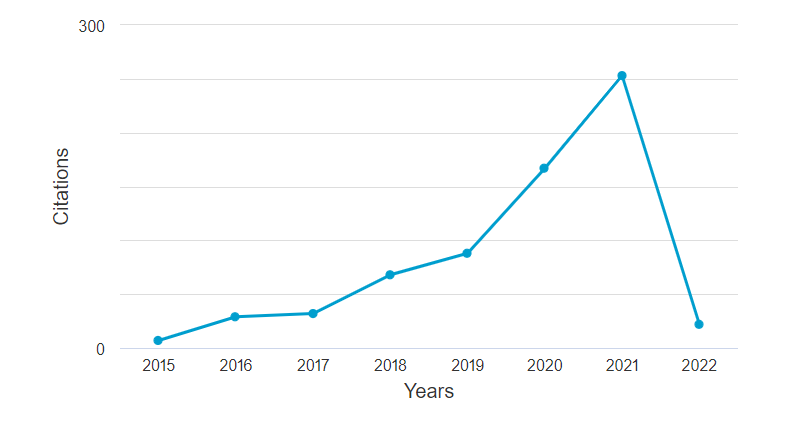
The data also indicates that articles published in 2018 received the highest number of citations, with a total of 68 citations. Additionally, articles published in 2020 received the highest number of citations per article, with an average of 2.95 citations per article. The table also provides information on the citable years of each article. The citable years refer to the number of years a particular article can be cited since its publication. The table shows that the articles published in 2015 had the most citable years, with a total of 6 years, while articles published in 2022 have negative citable years as the data for the current year is incomplete. Figure 1 indicates the annual citations trends for DH and CH.
Most Productive Authors
The Scopus database contains 194 journal articles related to digital humanities and knowledge transfer in cultural heritage preservation, with 612 scholars contributing to these publications. The top 10 most productive authors are listed in Table 4, with Eero Hyvönen and Pekka Leskinen being the most prominent authors, followed by Qun Wang, Stefan Münster, and Jennifer Nyhan. Table 4 also provides information on the number of articles each author has produced, their fractionalized articles, and the references for each article. This data can be highly valuable for researchers looking to explore new avenues and scope for future research in the field of digital humanities and cultural heritage preservation. By analyzing the contributions of prominent authors, researchers can gain insight into the most productive and influential scholars in the field and the areas in which they specialize. This information can help researchers to identify gaps in the literature and to develop new research projects that build on existing knowledge. Overall, Table 4 provides a valuable resource for researchers looking to understand the landscape of research in digital humanities and cultural heritage preservation.
Most Cited Papers for DH And KT in CH prospect
Table 5 lists the ten most cited papers in the field of digital humanities and cultural heritage preservation. The paper with the highest total citations is "Machine Learning for Cultural Heritage: A Survey" by Fiorucci et al. (2020), which has been cited 37 times in total. The paper with the highest normalized citation count is also "Machine Learning for Cultural Heritage: A Survey", with a normalized citation count of 12.537. Other highly cited papers include "Exploring Big Historical Data: The Historian's Macroscope" by Graham et al. (2015), "Exploring Entity Recognition and Disambiguation for Cultural Heritage Collections" by van Hooland et al. (2015), and "Twitter as a First Draft of the Present: And the Challenges of Preserving it for the Future" by Bruns and Weller (2016). The data in Table 5 provides valuable information for researchers in the field of digital humanities and cultural heritage preservation, highlighting the most cited papers and the areas of research that have received the most attention.
Most Productive Countries for DH And KT in CH prospect
Table 6 lists the top 10 countries that have contributed the most to the field of digital humanities and knowledge transfer in cultural heritage, as recorded in the Scopus database. The table shows the total number of publications each country has produced, as well as the percentage of the total publications.
According to the table, Italy tops the list with 74 publications, representing 13.7% of the total publications. Germany follows closely behind with 63 publications, accounting for 11.7% of the total. The UK comes in third place with 56 publications, representing 10.4% of the total. Other countries that made it to the top 10 list include Finland, the USA, China, and etc. The data provided by Table 6 highlights the global interest in digital humanities and knowledge transfer in cultural heritage. It is interesting to note that countries from different parts of the world have contributed to this field, showcasing the interdisciplinary nature of this research area. The results also indicate that research on digital humanities and knowledge transfer in cultural heritage is a topic of significant importance in Europe, with the top three countries being from the continent. This data can be useful to identify potential collaborators and research partners in different countries and priorities of different regions and countries, which can help inform future research agendas and collaborations.
Most relevant affiliations for Digital Humanities (DH) in Cultural Heritage (CH)
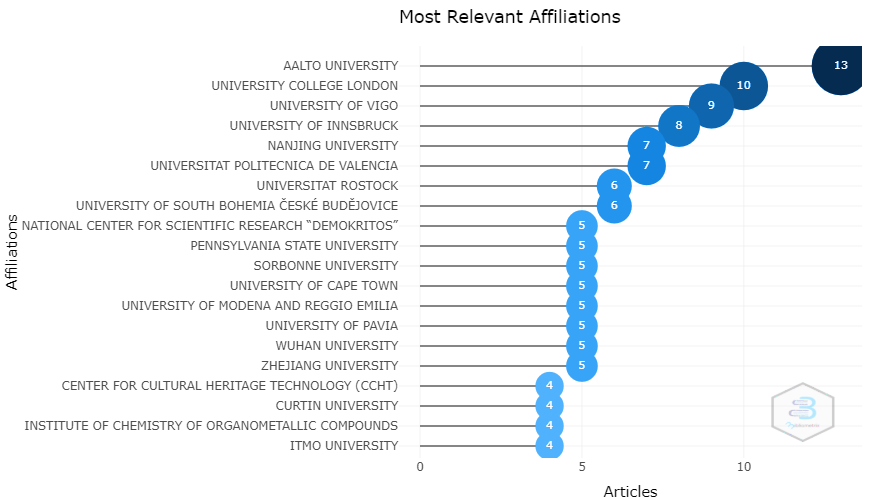
Figure 2 displays the top ten most relevant affiliations for Digital Humanities (DH) in Cultural Heritage (CH) based on the number of publications they have produced. Aalto University of Finland ranks first, having published 13 papers in the field, followed closely by University College London with 10 papers. The figure provides an overview of the institutions that are leading the way in DH research in CH, and highlights where researchers can find potential collaborators or expert resources. In addition to the affiliations, the publication venues for DH in CH are also crucial for researchers to consider. As stated, the 99 papers that were chosen for publication in this study were published in 20 different journals. Table 6 provides a breakdown of the top ten most frequently cited sources based on the collected data. The table shows that the most frequently cited publications are the "CEUR Workshop Proceedings" and the "ACM International Conference Proceeding Series." This information can be useful for researchers who want to explore the most highly regarded journals or conference proceedings in DH research in CH and guide them to contribute to these influential platforms.
Overall, Figure 2 and Table 6 provide valuable insights into the most relevant affiliations and publication venues for DH in CH research. Researchers can use this information to identify potential collaborators, sources of expertise, and highly respected publications. This, in turn, can help promote and advance research in the field, leading to new discoveries and innovation in DH and CH.
Bradford’s Law
This statistical method that has been used to analyse the distribution of scientific literature in a given field. It states that a small number of journals contribute to the majority of articles published in a particular subject area, while a large number of journals contribute relatively few articles. By applying Bradford's law to the data on Digital Humanities and Cultural Heritage publications, the most frequently referenced journals in this field can be identified. Using Bradford's law and four-zone models, researchers have identified the core journals in the field of Digital Humanities and Cultural Heritage. These core journals include CEUR Workshop Proceedings, Scopus Lecture Notes, ACM Conference Proceedings, and Communication in Computer Journal. These journals have published a significant number of articles in this field, and are therefore considered the main journals for this area of study.
Moreover, the identified core journals are likely to contain articles on specific subtopics within Digital Humanities and Cultural Heritage. This enables researchers to target their search to these core journals, thus saving time and resources. Figure 3 shows the Bradford’s Law for Source Log and Number of Articles.
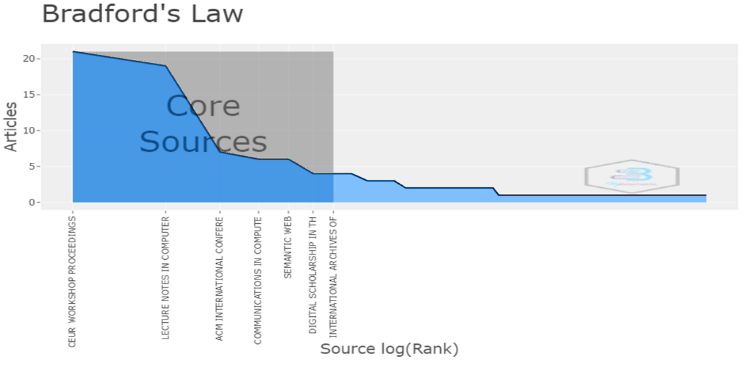
Most published and cited article
This table 7 presents the bibliometric indicators of the top 10 most cited sources in the field of Digital Humanities and Cultural Heritage. The indicators include h-index, g-index, m-index, total citations (TC), number of papers (NP), and publication year (PY_start). The sources are listed in descending order of h-index, a measure of the impact of a source based on the number of publications and their citations. The most cited source is the CEUR Workshop Proceedings, with an h-index of 1, g-index of 1, m-index of 0.5, 2 total citations, 2 number of papers, and a publication year starting from 2020. The next two sources on the list, Lecture Notes in Computer Science and ACM International Conference Proceeding Series, also have an h-index of 1, but with different values for other indicators.
Journal of Documentation has the highest h-index of 2 and a g-index of 3, indicating its high impact and productivity in the field. The other sources on the list have an h-index of 1 and varied values for the other indicators. Overall, the table provides insights into the most cited sources in Digital Humanities and Cultural Heritage, highlighting the importance of conference proceedings and journals in the field. It also shows the need for further research to identify and evaluate new sources that contribute to the advancement of this field.
Most frequent journals for DH in CH
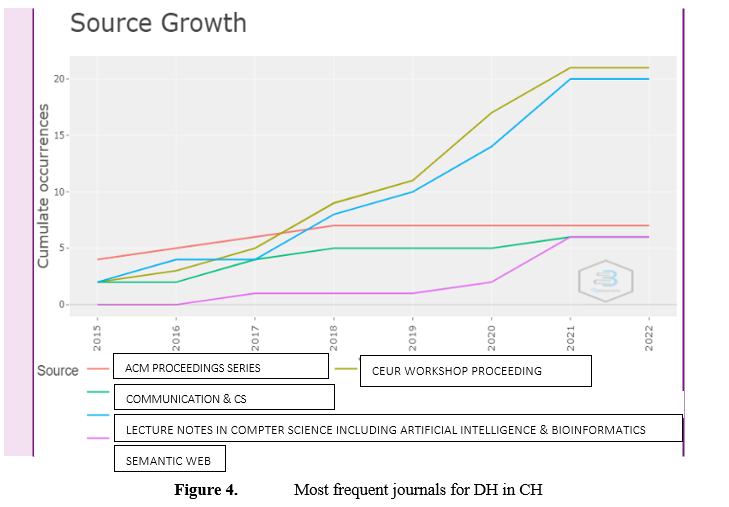
Figure 4 presents a detailed overview of the evolution of journal output in the field of digital humanities over time. The graph demonstrates that initially, the "ACM International Conference Proceeding Series" had the highest number of published papers, followed closely by "CEUR Workshop Proceedings". However, as time progressed, other journals in the field began to yield significant results, with "Lecture Notes in Computer Science" emerging as one of the top contributors to the field. This trend highlights the growth and development of digital humanities research, with an increasing number of journals contributing to the field over time. The graph serves as a valuable reference point for researchers and academics seeking to gain insights into the publication history of digital humanities and track the evolution of the field over time.
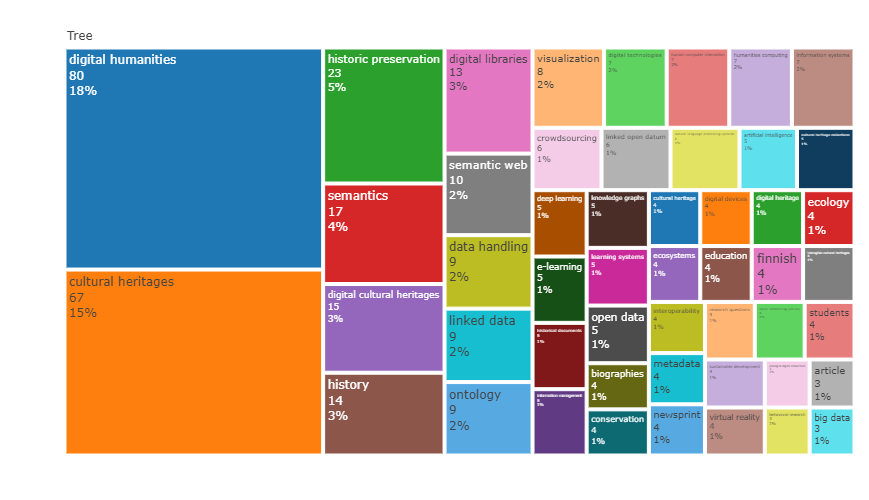
In Figure 5, the frequency and occurrences of author keywords have been analyzed and presented in a tree format, which enables the visualization of the percentage of each keyword. This analysis helps to identify the most common and relevant keywords used by authors in the field of digital humanities and cultural heritage research. The results demonstrate that the top five author keywords are digital humanities, cultural heritage, historic preservation, semantics, and digital cultural heritage, which account for 18 percent, 15 percent, 5 percent, 4 percent, and 3% of the total keywords used by authors, respectively. The high frequency of these keywords indicates their importance and relevance to the field of digital humanities and cultural heritage research, and highlights the key topics and themes that researchers are exploring in their studies.
Network Analysis:
Using the co-citation link, two articles are linked together, indicating that they are mentioned in the same research piece, resulting in a co-citation. The retrieved data was subjected to co-citation analysis to construct a network. As can be seen in Figure 6, the short-listed publications' bibliographies include the 20 most often mentioned sources. In the co-citation map, there are four distinct groups of red, purple, green, and blue dots. Discipline-oriented study has resulted in specialisation to the point that programmes and policies increasingly favour efforts that go beyond conventional academic bounds. Transdisciplinary research combines methods and ideas from other academic disciplines to address a problem or achieve a goal that is larger than the scope of a single field of Digital Humanities and Cultural Heritage. This can help researcher to identify patterns, clusters of authors who work together on specific research topics or who belong to specific institutions.
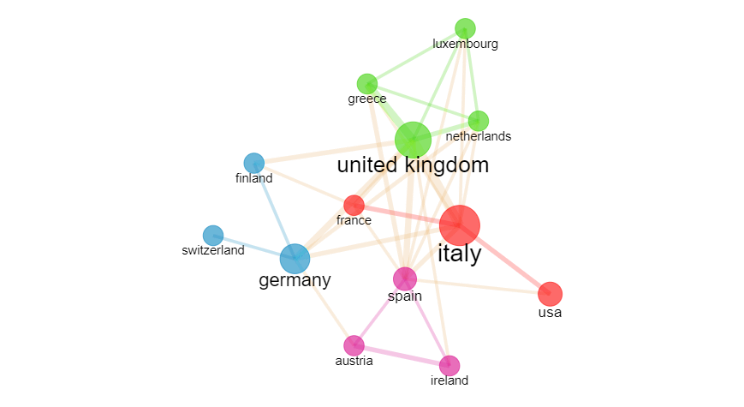
Co-Citation Analysis by Journal, Author & Field
Co-Citation Analysis involves identifying the frequency with which two articles or authors are cited together in the same context. In this method, it is divided into 3 panels or categories. The DE, AU, and SO are fields or variables used in bibliometric co-citation analysis in R. DE refers to the co-occurring keywords or terms in the titles, abstracts, or keywords of co-cited publications, AU refers to the co-occurring authors in the references list of co-cited publications, and SO refers to the co-occurring sources in the references list of co-cited publications. These fields are used to create co-citation networks that visualize the relationships between publications, authors, or sources. The underlying assumption behind co-citation analysis is that articles or authors that are frequently cited together are related in some way, either because they address similar topics or because they share some conceptual framework. From this, it can help researchers identify the most influential articles or authors in a particular field or subfield. For example, it suggests that Lecture notes in computer science and artificial intelligence are both important to the development of the field and are likely to have a significant impact on future research in the area. Aside from that, it also identifies clusters or networks of related articles or authors focusing on digital humanities and cultural heritage. This can help researchers to map the intellectual structure of a particular field or subfield and to identify potential research gaps or opportunities for interdisciplinary collaboration by following data stated in the DE panel. In addition to co-citation analysis at the article and author level, it can also be done at the journal and field level. For example, researchers can use co-citation analysis to identify the most influential journals in a particular field or to track the evolution of a field over time.
Discussion
The study on digital humanity in the domain of cultural heritage is still in its infancy and the papers are scarce, according to the results gathered. Digital humanities, digital cultural heritage, and historic preservation were the primary areas of study. However, integration on DH and knowledge transfer are rarely discussed or published in Scopus. Reviews and contemporary studies must be examined under this topic for knowledge transmissions and illustrates that heritage legacy is still relevant.
The table 8 displays bibliometric analysis results of the number of articles, total citations, citable years, and the frequency of bibliometrics, scientometrics, and informetrics usage in the years 2015 to 2022. The analysis showed that digital humanities, digital cultural heritage, and historic preservation were the primary areas of study in the domain of cultural heritage. However, only 5.2% of the articles promoted the combination of applying bibliometrics, scientometrics, or informetrics in the advancement of research on this topic. The percentage of articles discussing bibliometrics was the highest among the three, while scientometric and informetric analysis were not used as much. Nonetheless, the study acknowledges the selectivity bias in the records, which may skew the distribution of historical and knowledge data.
The discoveries distinguished that the three utilized terms were covered reasonably founded on titles, abstract and keywords as indicated by authors. With the presence of the term having Digital Humanities a positive connection with the portion of bibliometrics, it shows contrasted with the presence of the other two terms (knowledge transfer and cultural heritage. DH term demonstrate a bigger portion of distributions on points connected with research assessment, findings, and theories.
Nonetheless, we do not wish to dismiss the concerns connected with the selectivity bias in the records, which is exacerbated by reuse patterns. Significant essential CH and KT articles and other publications have yet to be initiated, which can skew historical and knowledge distribution and scientific research. In spite of the large range of search criteria, many of which may be visualized, we are unable to dig down to answer unique research concerns since not all types of searches are feasible. Additionally, it is unable to alter, update, or do more advanced statistical analysis on the data. Using a web-based, publicly accessible platform to offer a research resource has its limits. There are several advantages to this method of distribution, including the fact that all users have access to the same body of evidence and that searches may be referenced and duplicated, fostering open data research techniques and open analysis.
Recommendations
Encourage more research and applications of DH technology in cultural heritage studies: The study also identifies potential areas of investigation in cultural heritage and recommends innovative research applications. Thus, there is a need to encourage more research in this area and promote the adoption of DH technology in cultural heritage studies.
Focus on developing knowledge transfer (KT) programs for DH in cultural heritage: The article emphasizes the need for a KT program for DH in the cultural heritage aspect. This will help in managing art, new media, creating digital libraries, archives, CH databases, and displaying them in innovative collections. Therefore, researchers and practitioners in this field should focus on developing effective KT programs that can facilitate the transfer of knowledge and skills in DH and cultural heritage.
Promote interdisciplinary collaboration: DH is an interdisciplinary field that requires collaboration between researchers and practitioners from different disciplines such as humanities, computer science, information science, and others. Therefore, there is a need to promote interdisciplinary collaboration to foster innovation in DH and cultural heritage studies.
Conduct more bibliometric analysis: The study uses bibliometric analysis to analyze the trends in DH applications for knowledge transfer in cultural heritage studies. More bibliometric analysis can help in identifying emerging trends and areas of research that require more attention. Therefore, researchers should conduct more bibliometric analysis to gain insights into the current state and future directions of DH and cultural heritage studies.
Conclusion
According to the limited literature, knowledge transfer terms have a strong territorial component and emerge based on values and it can be applied to enhance cultural identity. In many mainstream literatures on knowledge transfer, it frequently refers to the technology sector, relationships between individuals and social interactions to play a fundamental role in promoting knowledge circulation. Technology, creativity, and passion flow between researchers also includes knowledge made possible by shared cultural values. However, the motivations for knowledge transfer come from the pursuit of heritage, can divulge innovation, increasing competitiveness, and figuring out how to integrate various types of traditional knowledge to understand the particulars issues and best preservation method of cultural heritage. This study advances the transdisciplinary character of humanities by concentrating on how the data were described, displayed, and organized might be used to many aspects of information and knowledge management, as well as empowering cultural heritage sustainability. Even though the present study has important implications, the KT and CH research reproductions have a lack of empirical data, which suggests that future research could be conducted to verify these findings by gathering case data, test and refine it in other contexts to a diverse and cogency finding.
Acknowledgments
This research project owes its existence entirely to the scholarship generously granted by the Ministry of Higher Education Malaysia, and we wish to express our heartfelt appreciation to the Ministry for their invaluable financial support. Additionally, we would like to extend our gratitude to the Department of Information System at the Faculty of Management in Universiti Teknologi Malaysia, as well as the Information Science Studies department at the College of Computing, Informatics, and Media in Universiti Teknologi MARA (UiTM) Negeri Sembilan Branch, Rembau Campus, and UiTM Johor Branch, Segamat Campus for their significant insights and unwavering support.
References
Aladyshkin, I., Anosova, N., Kulik, S., & Ulyanova, S. (2019). Digital humanities: Prospects for knowledge transfer. Proceedings of the International Conference on Digital Technologies in Logistics and Infrastructure (ICDTLI 2019). DOI:
Bruns, A., & Weller, K. (2016). Twitter as a first draft of the present. Proceedings of the 8th ACM Conference on Web Science. DOI:
Cornia, M., Stefanini, M., Baraldi, L., Corsini, M., & Cucchiara, R. (2020). Explaining digital humanities by aligning images and textual descriptions. Pattern Recognition Letters, 129, 166-172. DOI:
de Boer, V., Oomen, J., Inel, O., Aroyo, L., van Staveren, E., Helmich, W., & de Beurs, D. (2015). DIVE into the event-based browsing of linked historical media. Journal of Web Semantics, 35, 152-158. DOI:
Edmond, J., & Lehmann, J. (2021). Digital humanities, knowledge complexity, and the five 'aporias' of digital research. Digital Scholarship in the Humanities, 36(Supplement_2), ii95-ii108. DOI:
Fiorucci, M., Khoroshiltseva, M., Pontil, M., Traviglia, A., Del Bue, A., & James, S. (2020). Machine
Garzotto, F., Paolini, P., & Sabiescu, A. (2010). Interactive storytelling for children. Proceedings of the 9th International Conference on Interaction Design and Children. DOI:
Graham, S., Milligan, I., & Weingart, S. (2015). Exploring Big Historical Data. World Scientific Publishing. DOI:
Grifoni, E., Legnaioli, S., Nieri, P., Campanella, B., Lorenzetti, G., Pagnotta, S., Poggialini, F., &
Joseph, W. Y. (2020). Digital Knowledge Integration (DKI): When Transhumanism (H+) Meets Digital Humanities (DH). International Journal of Pedagogy, Innovation and New Technologies, 7(1), 39-49. DOI:
Kajberg, L., & Lørring, L. (2005). European Curriculum Reflections on Library and Information Science Education. Royal School of Library and Information Science.
Kim, J. (2020). The Future Past of Humanities Research: Musing Methodology in the Digital Convergence Era. International Journal of Advanced Smart Convergence, 9(3), 161–168. DOI:
Learning for Cultural Heritage: A survey. Pattern Recognition Letters, 133, 102–108. DOI:
Nonaka, I. (1994). A Dynamic Theory of Organizational Knowledge Creation. Organization Science, 5(1), 14-37. DOI:
Oiva, M. (2020). The Chili and Honey of Digital Humanities Research: The Facilitation of the Interdisciplinary Transfer of Knowledge in Digital Humanities Centers. DHQ: Digital Humanities Quarterly, 14(3), 1-17.
Organisation for Economic Co-operation and Development. (2016). Innovating Education and Educating for Innovation: The Power of Digital Technologies and Skills. OECD Publishing.
O'Sullivan, J., Jakacki, D., & Galvin, M. (2015). Programming in the Digital Humanities. Digital Scholarship in the Humanities, fqv042. DOI:
Palleschi, V. (2018). Construction and comparison of 3D multi-source multi-band models for cultural heritage applications. Journal of Cultural Heritage, 34, 261–267. DOI:
Robinson, P. M. W. (2016). Project-based digital humanities and social, digital, and scholarly editions. Digital Scholarship in the Humanities, 31(4), 875-889. DOI:
Ross, S., & Hedstrom, M. (2005). Preservation research and sustainable digital libraries. International Journal on Digital Libraries, 5(4), 317-324. DOI:
Sabharwal, A. (2015). Digital Curation in the Digital Humanities: Preserving and Promoting Archival and Special Collections (1st Ed.). Chandos Publishing. DOI:
Tuomi, I. (1999). Data Is More than Knowledge: Implications of the Reversed Knowledge Hierarchy for Knowledge Management and Organizational Memory. Journal of Management Information Systems, 16(3), 103-117. DOI:
UNESCO World Heritage Centre. (2020, April 14). Notre Dame: One year after the fire. https://whc.unesco.org/en/news/2102
van Hooland, S., De Wilde, M., Verborgh, R., Steiner, T., & Van de Walle, R. (2015). Exploring entity recognition and disambiguation for cultural heritage collections. Digital Scholarship in the Humanities, 30(2), 262-279. DOI:
Wang, Q. (2018). Distribution features and intellectual structures of digital humanities: A bibliometric analysis. Journal of Documentation, 74(1), 223-246. DOI:
Zeng, M. L. (2019). Semantic enrichment for enhancing LAM data and supporting digital humanities. Review article. El Profesional de la Información, 28(1). DOI:
Copyright information

This work is licensed under a Creative Commons Attribution-NonCommercial-NoDerivatives 4.0 International License.
About this article
Publication Date
15 November 2023
Article Doi
eBook ISBN
978-1-80296-130-0
Publisher
European Publisher
Volume
131
Print ISBN (optional)
-
Edition Number
1st Edition
Pages
1-1281
Subjects
Technology advancement, humanities, management, sustainability, business
Cite this article as:
Othman, R., Ibrahim, O., Kamal, S. N. M., & Ahmad, M. (2023). Charting Digital Humanities: A Bibliometric View of Cultural Heritage. In J. Said, D. Daud, N. Erum, N. B. Zakaria, S. Zolkaflil, & N. Yahya (Eds.), Building a Sustainable Future: Fostering Synergy Between Technology, Business and Humanity, vol 131. European Proceedings of Social and Behavioural Sciences (pp. 42-58). European Publisher. https://doi.org/10.15405/epsbs.2023.11.4

